
Lol
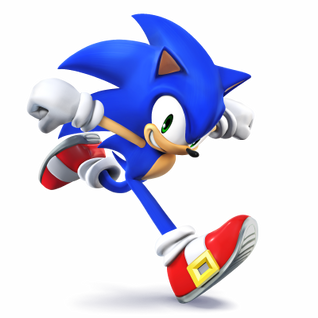
SSB4 OH YEAH!
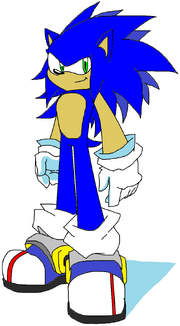
Me

SMU
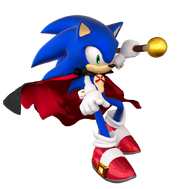

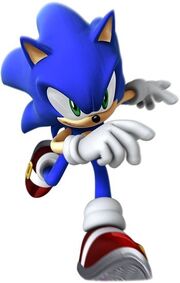
Sonic in Sonic The Hedgehog 2006

Sonic The Hedgehog In Sonic Adventure 3 fan game I'm Sonic Sonic The Hedgehog!

Sonic LAUGHING

Sonic in Sonic: lost World

Sonic The Hedgehog Crossed Hands

Sonic in Sonic SA2 pose

DERP
Sonic the Hedgehog (Japanese: ソニック・ザ・ヘッジホッグ Hepburn: Sonikku za Hejjihoggu?), trademarked Sonic The Hedgehog,[2] is the title character and protagonist of the Sonic the Hedgehog series released by Sega, as well as numerous spin-off comics, four animated shows, and an animated OVA. The first game was released on June 23, 1991, to provide Sega with a mascot to rival Nintendo's flagship character Mario (see 1991 in video gaming).[3][4] Since then, Sonic has become one of the world's best-known video game characters, with his series selling more than 80 million copies.[5] In 2005, Sonic was one of the first game character inductees into the Walk of Game, alongside Mario and Link.[6]
While many individuals at Sega had a hand in Sonic's creation, programmer Yuji Naka and artist Naoto Ōshima are generally credited with the creation of the character.[7] Sonic is a blue 15-year-old anthropomorphic hedgehog, who has the ability to run at supersonic speeds and the ability to curl into a ball, primarily to attack enemies. Throughout the course of his video games, Sonic most commonly has to race through levels, collect power up rings and surviving against a host of natural obstacles and minions to achieve his goal.

Shadic
While Sega was seeking a flagship series to compete with Nintendo's Mario series along with a character to replace Alex Kidd as the company's mascot, several character designs were submitted by its Sega AM8 research and development department. Many results came forth from their experiments with character design, including an armadillo (who later developed into Mighty the Armadillo), a dog, a Theodore Roosevelt look-alike in pajamas (who would later be the basis of Dr. Robotnik/Eggman's design), and a rabbit (who would use its extendible ears to collect objects, an aspect later incorporated in Ristar).[8][9] Eventually, Naoto Ōshima's spiky teal hedgehog, initially codenamed "Mr. Needlemouse",[3] was chosen as the new mascot. Sonic's blue pigmentation was chosen to match Sega's cobalt blue logo, and his shoes were a concept evolved from a design inspired by Michael Jackson's boots with the addition of
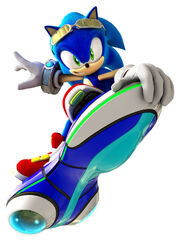
Sonic in Sonic Riders Zero Gravilty
the color red, which was inspired by both Santa Claus and the contrast of those colors on Jackson's 1987 album Bad; his personality was based on Bill Clinton's "Get it done" attitude.[8][10][11][12] Sonic was created without the ability to swim because of a mistaken assumption by Yuji Naka that all hedgehogs could not do so.[13] A group of fifteen people started working on the first Sonic the Hedgehog game, and renamed themselves Sonic Team. The game's soundtrack was composed by Masato Nakamura of the band Dreams Come True. Sega sponsored the group's "Wonder 3" tour, painting Sonic on the tour bus, distributing pamphlets advertising the game, and having footage of the game broadcast above stage prior to its release.[14] The original concepts gave Sonic fangs and put him in a band with a human girlfriend named Madonna. However, a team from Sega of America, led by

Madeline Schroeder, who calls herself "Sonic's mother",[8] "softened" the character up for an American audience by removing those elements. This sparked a heated issue with Sonic Team. Naka later admitted that it was probably for the best.[8] Sonic's appearance varies greatly depending on the medium and the style in which he is drawn. In the video games, Sonic's original design by Oshima was short and round, with short quills, a round body, and no visible irises. Artwork featuring this design and drawn by Akira Watanabe was displayed on the package artwork for Sonic the Hedgehog.[15] Sonic's proportions would change for the release of Sonic the Hedgehog 2 on the Mega Drive. Sonic's head to height ratio was changed from 1:2 to 1:2.5 for appeared.[15] For the 1998 release of Sonic Adventure, Sonic was redesigned by Yuji Uekawa as a character with longer legs and a less spherical body, longer and more drooping quills, and green-colored irises.
While Sega was seeking a flagship series to compete with Nintendo's Mario series along with a character to replace Alex Kidd as the company's mascot, several character designs were submitted by its Sega AM8 research and development department. Many results came forth from their experiments with character design, including an armadillo (who later developed into Mighty the Armadillo), a dog, a Theodore Roosevelt look-alike in pajamas (who would later be the basis of Dr. Robotnik/Eggman's design), and a rabbit (who would use its extendible ears to collect objects, an aspect later incorporated in Ristar).[8][9] Eventually, Naoto Ōshima's spiky teal hedgehog, initially codenamed "Mr. Needlemouse",[3] was chosen as the new mascot. Sonic's blue pigmentation was chosen to match Sega's cobalt blue logo, and his shoes were a concept evolved from a design inspired by Michael Jackson's boots with the addition of the color red, which was inspired by both Santa Claus and the contrast of those colors on Jackson's 1987 album Bad; his personality was based on Bill Clinton's "Get it done" attitude.[8][10][11][12] Sonic was created without the ability to swim because of a mistaken assumption by Yuji Naka that all hedgehogs could not do so.[13] A group of fifteen people started working on the first Sonic the Hedgehog game, and renamed themselves Sonic Team. The game's soundtrack was composed by Masato Nakamura of the band Dreams Come True. Sega sponsored the group's "Wonder 3" tour, painting Sonic on the tour bus, distributing pamphlets advertising the game, and having footage of the game broadcast above stage prior to its release.[14]
The original concepts gave Sonic fangs and put him in a band with a human girlfriend named Madonna. However, a team from Sega of America, led by Madeline Schroeder, who calls herself "Sonic's mother",[8] "softened" the character up for an American audience by removing those elements. This sparked a heated issue with Sonic Team. Naka later admitted that it was probably for the best.[8] Sonic's appearance varies greatly depending on the medium and the style in which he is drawn. In the video games, Sonic's original design by Oshima was short and round, with short quills, a round body, and no visible irises. Artwork featuring this design and drawn by Akira Watanabe was displayed on the package artwork for Sonic the Hedgehog.[15] Sonic's proportions would change for the release of Sonic the Hedgehog 2 on the Mega Drive. Sonic's head to height ratio was changed from 1:2 to 1:2.5 for appeared.[15] For the 1998 release of Sonic Adventure, Sonic was redesigned by Yuji Uekawa as a character with longer legs and a less spherical body, longer and more drooping quills, and green-colored irises. See also: Sonic the Hedgehog (series) and List of Sonic the Hedgehog video games
[1][2]Sonic's debut in his very own game in 1991, Sonic the Hedgehog.
Sonic's first appearance in video games was in the racing game Rad Mobile. Sonic's first major appearance was in the platform game Sonic the Hedgehog for the Sega Mega Drive/Genesis, which also introduced his nemesis Dr. Robotnik. His two-tailed fox friend Tails joined him in the game's 1992 sequel, Sonic the Hedgehog 2. Sonic CD, released in 1993, introduced Sonic's self-appointed girlfriend Amy Rose and recurring robotic doppelgänger Metal Sonic as Sonic traveled through time to ensure a good future for the world. Sonic 3 and its direct sequel Sonic & Knuckles, both released in 1994, saw Sonic and Tails battle Robotnik again, with the additional threat of Knuckles, who is tricked by Robotnik into thinking Sonic is a threat. Sonic 4 (2010-2012) continues where the story of Sonic 3 left off, reducing Sonic to the only playable character and releasing in episodic installments. The second episode sees the return of both Tails as Sonic's sidekick and Metal Sonic as a recurring enemy.
Other two-dimensional platformers starring Sonic include Sonic Chaos (1993), Sonic Triple Trouble (1994), Sonic Blast (1996), Sonic the Hedgehog Pocket Adventure (1999), Sonic Advance (2001), Sonic Advance 2 (2002), Sonic Advance 3 (2004), Sonic Rush (2005), Sonic Rush Adventure (2007), and

Sonic Colors (DS) (2010), all in which were released for handheld consoles.
Sonic Adventure (1999) was Sonic Team's return to the character for a major game. It featured Sonic returning from vacation to find the city of Station Square under attack by a new foe named Chaos, under the control of Dr. Robotnik (now known as Dr. Eggman). It was also the first Sonic game to feature a complete voice-over. Sonic Adventure 2 (2001) placed Sonic on-the-run from the military (G.U.N.) after being mistaken for Shadow the Hedgehog. Sonic Heroes (2003) featured Sonic teaming up with Tails and Knuckles, along with other character teams like Team Rose and Chaotix, against the newly rebuilt Metal Sonic, who had betrayed his master with intentions of world domination. Sonic the Hedgehog (2006) features Sonic in the city of water, "Soleanna," where he must rescue Princess Elise from Dr. Eggman while trying to avoid a new threat to his own life, Silver the Hedgehog. He is the only playable character in Sonic Unleashed (2008), in which he unwillingly gains a new personality, "Sonic the Werehog," the result of Sonic being fused with Dark Gaia's power. He gains strength and flexibility in exchange for his speed, and new friends including a strange creature named Chip who helps him along the way. In Sonic Colors (2010), Eggman tries to harness the energy of alien beings known as "Wisps" for a mind-control beam. The anniversary title Sonic Generations (2011) features two playable incarnations of Sonic: the younger "classic" Sonic, whose gameplay is presented in a style reminiscent of the Mega Drive/Genesis titles, and present-day "modern" Sonic, who uses the gameplay style present in Unleashed and Colors, going through stages from past games to save their friends. Sonic Generations features various theme songs including modern and retro versions that are able to be selected from throughout Sonic's twenty year history.[18]
Sonic and the Secret Rings (2007) features Sonic in the storybook world of One Thousand and One Nights. A sequel, titled Sonic and the Black Knight (2009), continued the storybook theme, this time taking place within the realm of the Arthurian legend.
Sonic has also been featured in other games of many genres other than 2D and 3D platform games. These include Sonic Spinball, Sonic Labyrinth (1995), the racing games Sonic Drift (1994), Sonic Drift 2 (1995), Sonic R (1996), Sonic Riders (2006), Sonic Rivals (2006), Sonic Rivals 2 (2007), Sonic Riders: Zero Gravity (2008), and Sonic Free Riders (2010), the fighting games Sonic the Fighters (1996) and Sonic Battle (2003), the mobile game Sonic Jump (2005), and the role-playing video game Sonic Chronicles: The Dark Brotherhood (2008).
Video games such as Dr. Robotnik's Mean Bean Machine (1993), Knuckles' Chaotix (1995), Tails' Skypatrol (1995), Tails Adventure (1995), and Shadow the Hedgehog (2005) starred supporting characters of the Sonic series, although Sonic himself cameos in most of these titles.
Sonic has appeared in several crossover titles, including a playable appearance in Super Smash Bros. Brawl (2008). He appeared in the crossover party game Mario & Sonic at the Olympic Games and in its sequels Mario & Sonic at the Olympic Winter Games and Mario & Sonic at the London 2012 Olympic Games. Sonic is also a playable character in all three Sega Superstars titles.
In April 2013, Sega announced that Sonic Lost World would launch in October 2013 for the Wii U and Nintendo 3DS.[
[3][4]Sonic and Mario in Super Smash Bros. Brawl
As Sega's mascot and one of the key reasons for the company's success during the 16-bit era of video game consoles, Sonic is one of the most famous video game characters in the world. In 1996, Sonic was the first video game character to be seen in a Rose Parade. Sonic is also the first video game character (later followed by Pikachu) to have a balloon in Macy's Thanksgiving Day Parade.[3] Sonic was one of the three game characters inducted on the inaugural Walk of Game class in 2005, along with former rivals Mario and Link (both from Nintendo).[6] One of a class of genes involved in fruit fly embryonic development, called hedgehog genes, has been named "sonic hedgehog" after the character.[36]
Sonic has also been used as a symbol for Sega's various sponsorships. Between 1993 and 1997, Sega sponsored the JEF United Ichihara Chiba football team, during which period Sonic appeared in the team's uniform.[37] During the 1993 Formula One championship, Sega sponsored the Williams Grand Prix team, which won the Constructors' Championship that year, as well as the team's lead driver, Alain Prost, winning the Drivers' Championship.[38] Sonic was featured in the cars, helmets, and their rivals McLaren used to paint a squashed hedgehog after winning races over Williams.[39] The 1993 European Grand Prix featured a Sonic balloon and Sonic billboards. Sonic also appears on some versions of the willow video store logo. According to a poll conducted during Sonic's height of popularity in 1990, the character was more recognizable to American children than Mario and Mickey Mouse.[40]
Nintendo Power listed Sonic as their sixth favorite hero, stating that while he was originally Mario's arch nemesis, he seems at home on Nintendo platforms. They added that he has remained as one of gaming's greatest icons.[41] In 2004, the character won a Golden Joystick Award for "The Sun Ultimate Gaming Hero".[42] On October 21, 2008, out of 500 people, Sonic was voted the most popular video game character in the UK with a 24% vote while his old rival Mario came second with 21% of the vote.[43][44] Then in late 2008, MSN held a poll of who's the most iconic video game character, Sonic was ranked #1 as the most iconic video game character of all in gaming while Mario and Lara Croft were voted less in second and in third respectively.[45] In 2011, Empire ranked him as the 14th greatest video game character.[46] And he was voted 10th out of the top 50 video game characters of all time in Guinness World Records 2011 Gamers' Edition.[47] Sonic ranked ninth on GameDaily's Top 10 Smash Bros characters list.[48] GameDaily also listed his "next-generation stumble" in their list of video game characters' worst moments, using his relationship with a human female as one of the worst parts of it.[49]
Ken Balough, Sega's associate brand manager, said that Sonic's appeal endured because the character is "a gaming legend, first and foremost" who originated "from a series of games that defined a generation in gaming history, and his iconic personality was the epitome of speed in the early ‘90s, pushing the limits of what gamers knew and expected from high-speed action and platforming games."[50]
- Sonic CD: "Sonic Boom" (US)- Pastiche/ "Sonic - You Can Do Anything" - Keiko Utoku (JPN/EUR)
- Sonic Adventure: "It Doesn't Matter" / "Open Your Heart" - Crush 40. The latter serves as the main/final boss theme.
- Sonic Adventure 2: "It Doesn't Matter" / "Live and Learn" - Crush 40. The latter serves as the main/final boss theme.
- Sonic Heroes: "We Can" - Ted Poley, Tony Harnell. This theme is also shared with Tails and Knuckles, considering that this is also the Team Sonic theme.
- Sonic the Hedgehog '06: "His World" - Zebrahead. This is one of the three character theme songs and 2 instrumental versions (one of which is used for the final boss theme) can be found in the game. Other remixes of this theme were done by Crush 40 and Bentley Jones.
- Sonic and the Secret Rings: "Seven Rings In Hand" - Steve Conte. This theme is also played during the final battle of the game with Darkspine Sonic (A dark form of Super Sonic with seven world rings) Vs. Alf Laya Wa Laya (seven world rings transformation of Erazor Djinn)
- Sonic Riders: Zero Gravity: "Un-Gravitify" - Kenichi Tokoi (music), runblebee (lyrics), and Cashell (vocals)
- Super Smash Bros. Brawl: "Live and Learn" - Crush 40/ "Sonic Boom" - Pastiche/ "Angel Island Theme" (remake) (there were at least 2 more Sonic theme songs in this game)
- Sonic Unleashed: "Endless Possibility" - Bowling For Soup. This theme also serves as the final boss theme (Perfect Dark Gaia) as an orchestral, instrumental theme.
- Sonic and the Black Knight: "Knight of the Wind" - Crush 40. This theme also plays during the credits of the game's first ending.
- Sonic Colors/Colours: "Reach for the Stars" - Cash Cash. This theme also serves as the final boss theme in the Terminal Velocity Zone as an orchestral, instrumental theme. A retro version can also be found when any color power is being activated in Game Land.
- Super Speed
- Super Sonic
- Dark Super Sonic
- DarkSpine Sonic
- The first Sonic The Hedgehog game ever released was Sonic The Hedgehog for the Mega Drive in 1991.

Dat sonic has swag eh?


Sonic in Wreck it - Ralph